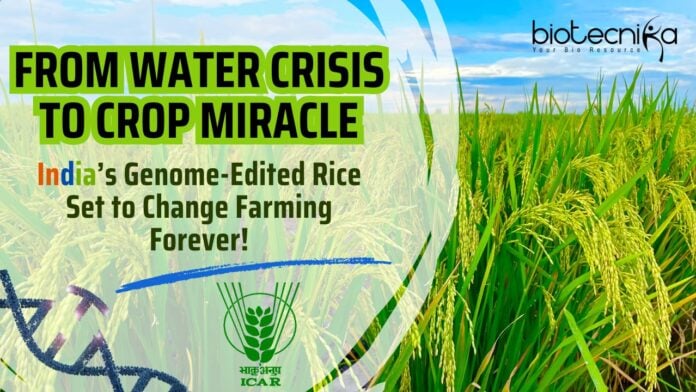India’s Genome-Edited Rice Set to Change Farming Forever!
We live in a country where rice/paddy fields stretch endlessly across the landscape, providing food to millions of people who depend on this staple for their survival. Rice isn’t just a crop; it is the lifeblood of India. Yet, it deals with daunting crises such as water scarcity as well as climate change, which is intensifying with time. With depleting water resources and increasing climate change, the future of our country’s Rice cultivation is shaky.
Visualise a rice variety that requires less water, reduces harmful emissions, as well as yields more crop. Do you think that could be a reality? What if Science and Technology hold the key to making this possible? Could this be the turning point for India and the world, needing to secure water and food for future generations?
India has made a historic leap in Sustainable Farming by unveiling the world’s first Genome-Edited Rice varieties. “Pusa DST Rice 1” and “DRR Dhan 100 (Kamala).” These incredible rice varieties were developed by the ICAR (Indian Council of Agricultural Research). These advanced innovations have the power to revolutionize Rice cultivation, particularly in climate-vulnerable as well as water-stressed regions.
This historic milestone aligns with our country’s visionary goals of conserving water, building resilience to climate change, as well as ensuring food security. In India, Rice is a staple for over 800 million Indians and a major contributor to Greenhouse gas emissions as well as Agricultural water use.
Are you ready to understand the Science behind this and see how this innovation would transform India’s as well as the world’s Agriculture? Then dive deeper and read on!
The Innovation – Rice Cultivation With Lower Water Usage, Reduced Emissions, and Enhanced Yields, India’s Genome-Edited Rice Set to Change Farming Forever!
According to the ICAR Researchers, cultivating these genome-edited Rice lines across an area of 5 million hectares could lead to an additional 4.5 million tonnes of rice. This would save up to 7,500 million cubic metres of irrigation water, which would be a remarkable gain in our system, where conventional Rice varieties require around 2,500 litres of water per kilogram of grain. Furthermore, more than 50% of Agricultural irrigation water is consumed by Rice cultivation in our country.
These novel rice varieties were developed to address three major climate challenges: water utilization, Environmental impact, as well as Rice productivity.
Scientists claim that these Rice varieties promise an enhanced yield of 20–30%. They also stated that due to these varieties, there would be a reduction in Methane (Greenhouse gas) emissions by nearly upto 20%, which could be a significant climate advantage since the paddy fields are a prime source of this gas emission.
Why Genome Editing Matters: A New Age in Crop Improvement
The innovative Technology behind the success of these rice varieties is Precision Genome Editing. This technology allows Scientists to execute targeted modifications in the plant’s DNA (Deoxyribonucleic acid) without introducing any foreign genes, which is a major difference from GMOs (Genetically Modified Organisms).
India’s Rice varieties were developed utilizing the following two techniques:
- SDN1 (Site-Directed Nuclease 1)
- SDN2 (Site-Directed Nuclease 2)
These advanced techniques developed Genetically Edited Organisms whose modifications were indistinguishable from conventional or natural mutations. This resulted in safer crops that mimicked those varieties developed through traditional breeding. Moreover, due to this technique, they were exempted from the Bio-Safety Regulations under Rules 7 – 11 of the Environment (Protection) Act, 1986.
The Joint Director (Research) and a lead scientist at ICAR, Dr. Viswanathan Chinnusamy, stated, “Plants with genome-edited seed varieties do not contain foreign DNA, unlike genetically modified crops. Hence, they have no health or environmental concerns.”
Evolving Regulations: Science-Driven and Risk-Based
Since SDN1 & SDN2 Genome Edits don’t introduce any foreign DNA, India has adopted a responsible Regulatory framework.
The key approvals include:
- IBC (Institutional Biosafety Committee) clearances from the ICAR institutes
- RCGM (Review Committee on Genetic Manipulation) approval granted on May 31, 2023, affirming that these Rice varieties are exempt from GMO-like Bio-Safety regulation.
Ethical & Safety Concerns
Despite the Scientific support, opposition groups like the “Coalition for a GM-Free India” have raised their concerns regarding these Rice varieties. They have demanded the withdrawal of these two Genome-Edited Rice varieties, citing potential risks to human health, seed sovereignty, and ecological balance.
They conveyed their concerns that even Genome-Edited Crops, despite lacking any foreign genes, should undergo rigorous scrutiny similar to GMOs, especially in the context of corporate control over seeds as well as long-term impacts. They said that there Rice varieties could potentially damage the environment, threaten country’s seed sovereignty as well as harm humans.
But since these Genome-Edited Rice varieties don’t contain any foreign DNA, they can be comparable to traditionally bred Rice varieties.
Targeted Innovation for India’s Agro-Climatic Realities
The NRRI (India’s National Rice Research Institute) has long identified unsustainable water consumption in cultivating Rice. An NRRI Research paper focused on Rice production systems used for managing water, stating, “In the next two decades, we need to produce around 25% more rice from 10–15% less water.”
In 2018, ICAR introduced a Genome-Editing Program, targeting widely grown Rice varieties such as MTU1010 (Cottondora Sannalu) and BPT5204 (Samba Mahsuri), as a response to the environmental challenge. The main goal was to enhance yield, climate adaptability, as well as boost drought and heat tolerance without compromising on the disease resistance or cooking quality of parent Rice lines.
The resulting varieties, Pusa DST Rice 1 and DRR Dhan 100, retain the grain quality as well as the consumer acceptance of their predecessors’ Rice varieties while improving performance under climate strain.
Where These Rice Varieties Will Be Deployed
Currently, these innovative Rice varieties are cleared for suitability in Union Territories (UT) and States where their parent varieties are already popular. This includes: Tamil Nadu, Puducherry, Kerala, Karnataka, Telangana, Andhra Pradesh, Maharashtra, Chhattisgarh, Madhya Pradesh, Odisha, Bihar, West Bengal, Eastern Uttar Pradesh, and Jharkhand.
ICAR is accessing IPR (Intellectual Property Rights) before handing over these novel seeds to the farmers. After pending seed multiplication and final regulatory clearances, the seeds will be available to farmers within two years.
Global Implications: India Sets a Precedent
With these innovative Rice varieties, India has become the first nation to introduce Genome-Edited Rice globally. This sets a novel example in Global Agricultural Biotechnology.
This innovation advances India’s position in Sustainable crop innovation, providing a blueprint for countries struggling with climate change, food insecurity, as well as water scarcity.
“With genome editing, we have an unprecedented opportunity to ensure food security while preserving our natural resources,” said Dr. Chinnusamy.
The Future of Rice Is Here
The launch of Pusa DST Rice 1 and DRR Dhan 100 marks a pivotal shift in how India approaches Agriculture, blending advanced Science with Ecological responsibility.
As water scarcity looms and climate change intensifies, Genome-Edited Crops offer a path toward resilient, resource-efficient, as well as Sustainable Agriculture. The road ahead requires robust regulatory oversight, constructive dialogue with stakeholders, as well as continued transparency. But India’s bold move could be a game-changer – not just for farmers but for our planet.
These new rice varieties offer hope for millions of farmers and consumers alike, promising more food, less water, and a healthier planet. This breakthrough is not just a win for Agriculture but a beacon of progress and sustainability. The real question now is how fast this revolution can spread to reshape farming and secure food for generations to come.























